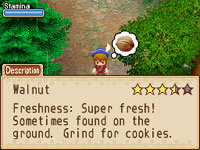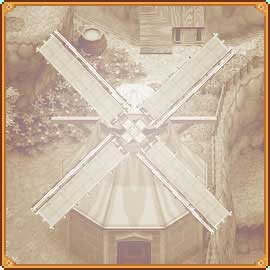Star Rank and Freshness
Items in Grand Bazaar often have a star quality rank. This rank is stamped in the upper-left corner of the item description, located on the top screen when you are looking at the item in your rucksack. The star quality ranges from 0 stars to 5 stars with half-star increments; you can have an item that has 1 full star or .5 stars.
Items that can rot (decay) will also have a freshness listed on the item description. The freshness ranks are:
- Super Fresh!
- Fairly Fresh
- Not so Fresh
- Getting bad
- It's rotten...
Stars, Freshness, and Sell Profit

The combination of star quality, freshness, and location determines the best sale price for the item. The most gold you can earn from an item is when it has 5 stars, Super Fresh quality, and you sell it at the bazaar. If an item has 0 stars and "rotten" status, then you will earn nothing for it no matter where you try to sell it.
The star quality will vary depending on what the item is. For example, with animal products the star quality is based on the number of hearts the animal has. For crops, it is based on how much fertilizer was used. Cooked recipe stars are from the combination of the ingredient's star quality (and possibly your cooking level), fish stars are from the the rank of your fishing pole, while bugs and other wild items are based how many years you've proceeded through the game.
Freshness is the second factor that determines how much money you'll earn when you sell the item. You will earn the most (100%) if you sell your item when it is at a Super Fresh stage. The more rotten an item is, the less you'll earn; Fairly Fresh is 80%, Not so Fresh is 60%, Getting bad is 30%, and at "It's rotten" stage you won't earn anything at all for the item.
Not every item has freshness though; items such as ores, gems, bugs, seeds, and some processed items like cans of tea don't have a freshness rating associated with them. You can keep these items as long as you want and they'll still sell for the same amount.
The last factor that determines your profit is the location where you sell the item. If you sell the item at your bazaar booth, you will earn 80% of the item's potential profit. If you sell the item at a villager's shop, either at the bazaar or in town, you will only earn 50% of the item's potential profit! It is always ideal to sell your items at your own booth at the bazaar.
Only villagers can earn 100% of an item's profit when they sell it at their shops. Seems unfair, but that's how it goes! This is to prevent you from buying an item from someone's shop, then reselling it back at your bazaar booth for a profit.
Profit Examples
Corn is a summer crop that sells for 800 G at your bazaar booth if it has 5 stars and Super Fresh quality. If you sell it to Raul at his shop (50%), you'll only earn 400 G (800 G x .5 = 400 G).
If you couldn't sell all of your corn during the bazaar and held onto it for a week, the corn might rot down to a Fairly Fresh rank. If you sell it at your booth, then you will earn 640 G (800 G x .8 = 640 G). If you sold that corn at Raul's, then it is even less; 800 G x .8 = 640 G x .5 = 320 G!
(When calculating profit, round down if the last digit is 1, 2, 3, or 4. Round up for a 5, 6, 7, 8, or 9. For example, if you calculated a sell profit of 344 G, round down to 340. If it was 348, then it will be 350 G.)
Item Decay Rates
Items that can lose freshness are crops, fish, animal products such as milk, cheese, etc. (except for wool), cooked recipes, and foraged items (flowers, etc.).
| Rank | Points |
|---|---|
| It's rotten... | 0 |
| Getting bad | 1 to 20 |
| Not so Fresh | 21 to 40 |
| Fairly Fresh | 41 to 70 |
| Super Fresh! | 71 to 100 |
Freshness is based on a point scale; the more points the item has, the fresher it is. You can't see the point freshness value for each item. When a item has zero points of freshness, then it is completely worthless to sell as-is.
Each day the game will calculate a decay rate for each item you own that can rot. This is calculated based on the season that you are in, the current item's freshness point value, the type of item it is, and where the item is being stored:
- Season: Summer is when items decay the fastest, with a point value of 4. Spring and Fall are both with a point value of 2, and then in Winter things slowly decay (since it's so cold) and it has a point value of 1.
- Current Points: Each morning the freshness is calculated based on the item's current point value. This will decrease every day until the item is rotten.
- Type of Item: Some items decay faster than others. Wild items and milk decay the fastest (point value 3), then comes fish (point value 2), cooked and processed items (1), and lastly crops and eggs (0).
- Location: If you keep an item in your rucksack, it will decay faster than if you stored it in your storehouse. Gannon can enhance your storehouse to increase its preservation value.
Current Points - (Season + Type - Location) = Freshness Points
If you had picked up a Mint in Summer, it starts with 100 Freshness Points. If you kept it in your rucksack, the next day it would have 93 Freshness Points:
100 - (4 (Summer) + 3 (Type) - 0 (Rucksack)) = 93 points
This means it will take 5 days for a Mint to decay down to Fairly Fresh if you kept it in your rucksack during Summer season. If you immediately put the Mint in your powered-up level 2 storehouse instead:
100 - (4 (Summer) + 3 (Type) - 2 (level 2 storehouse) = 95 points
Now it will take 6 days to decay to Fairly Fresh. You can upgrade your storehouse three times. Power Up #1 increases your storehouse to preservation level 2, Power Up #2 upgrades it to preservation level 3, and the last 100,000 G upgrades maximizes your storehouse to preservation level 4. The same Mint in a max leveled storehouse will take 10 days to decay.
